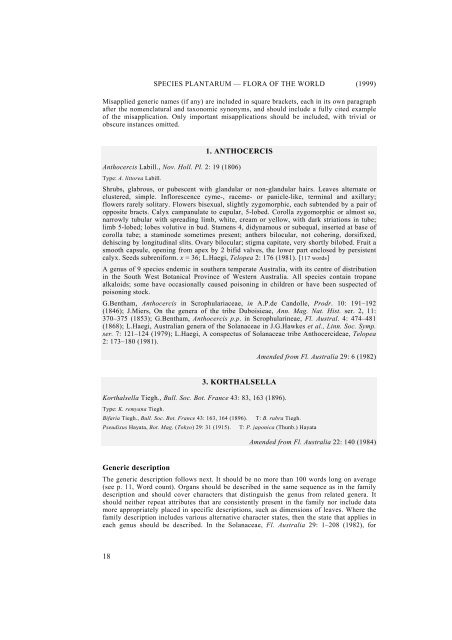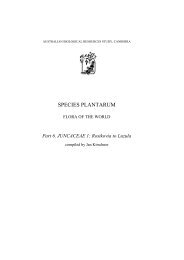Introduction - Species Plantarum Programme
Introduction - Species Plantarum Programme
Introduction - Species Plantarum Programme
You also want an ePaper? Increase the reach of your titles
YUMPU automatically turns print PDFs into web optimized ePapers that Google loves.
18<br />
SPECIES PLANTARUM — FLORA OF THE WORLD (1999)<br />
Misapplied generic names (if any) are included in square brackets, each in its own paragraph<br />
after the nomenclatural and taxonomic synonyms, and should include a fully cited example<br />
of the misapplication. Only important misapplications should be included, with trivial or<br />
obscure instances omitted.<br />
1. ANTHOCERCIS<br />
Anthocercis Labill., Nov. Holl. Pl. 2: 19 (1806)<br />
Type: A. littorea Labill.<br />
Shrubs, glabrous, or pubescent with glandular or non-glandular hairs. Leaves alternate or<br />
clustered, simple. Inflorescence cyme-, raceme- or panicle-like, terminal and axillary;<br />
flowers rarely solitary. Flowers bisexual, slightly zygomorphic, each subtended by a pair of<br />
opposite bracts. Calyx campanulate to cupular, 5-lobed. Corolla zygomorphic or almost so,<br />
narrowly tubular with spreading limb, white, cream or yellow, with dark striations in tube;<br />
limb 5-lobed; lobes volutive in bud. Stamens 4, didynamous or subequal, inserted at base of<br />
corolla tube; a staminode sometimes present; anthers bilocular, not cohering, dorsifixed,<br />
dehiscing by longitudinal slits. Ovary bilocular; stigma capitate, very shortly bilobed. Fruit a<br />
smooth capsule, opening from apex by 2 bifid valves, the lower part enclosed by persistent<br />
calyx. Seeds subreniform. x = 36; L.Haegi, Telopea 2: 176 (1981). [117 words]<br />
A genus of 9 species endemic in southern temperate Australia, with its centre of distribution<br />
in the South West Botanical Province of Western Australia. All species contain tropane<br />
alkaloids; some have occasionally caused poisoning in children or have been suspected of<br />
poisoning stock.<br />
G.Bentham, Anthocercis in Scrophulariaceae, in A.P.de Candolle, Prodr. 10: 191–192<br />
(1846); J.Miers, On the genera of the tribe Duboisieae, Ann. Mag. Nat. Hist. ser. 2, 11:<br />
370–375 (1853); G.Bentham, Anthocercis p.p. in Scrophularineae, Fl. Austral. 4: 474–481<br />
(1868); L.Haegi, Australian genera of the Solanaceae in J.G.Hawkes et al., Linn. Soc. Symp.<br />
ser. 7: 121–124 (1979); L.Haegi, A conspectus of Solanaceae tribe Anthocercideae, Telopea<br />
2: 173–180 (1981).<br />
3. KORTHALSELLA<br />
Korthalsella Tiegh., Bull. Soc. Bot. France 43: 83, 163 (1896).<br />
Type: K. remyana Tiegh.<br />
Bifaria Tiegh., Bull. Soc. Bot. France 43: 163, 164 (1896). T: B. rubra Tiegh.<br />
Amended from Fl. Australia 29: 6 (1982)<br />
Pseudixus Hayata, Bot. Mag. (Tokyo) 29: 31 (1915). T: P. japonica (Thunb.) Hayata<br />
Amended from Fl. Australia 22: 140 (1984)<br />
Generic description<br />
The generic description follows next. It should be no more than 100 words long on average<br />
(see p. 11, Word count). Organs should be described in the same sequence as in the family<br />
description and should cover characters that distinguish the genus from related genera. It<br />
should neither repeat attributes that are consistently present in the family nor include data<br />
more appropriately placed in specific descriptions, such as dimensions of leaves. Where the<br />
family description includes various alternative character states, then the state that applies in<br />
each genus should be described. In the Solanaceae, Fl. Australia 29: 1–208 (1982), for












